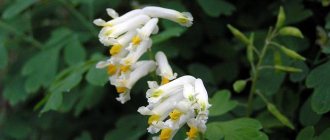Mimulus, also called gubastik, is a representative of the frim family. This genus is represented by herbaceous plants and subshrubs. Such plants can be found in the wild in all regions with a temperate climate except Europe. Previously, this genus was part of the Norichaceae family. The scientific name of the plant comes from the Latin word “mimus”, which translates as “imitator, mime”, this is due to the variable variegated color of the flower, as well as its unusual shape, which looks like a monkey’s face. This genus includes approximately 150 species, most of which can be found in the wild in the western part of North America in damp places, as well as in deserts and mountains at altitudes of up to 2.5 thousand meters above sea level. In mid-latitudes, mimulus has not yet gained much popularity among gardeners.
Description with photo of flowers
In its outline, the bud of the gubastik most closely resembles the face of a monkey. The genus is represented by semi-shrub or herbaceous plants belonging to the Frimov family, and includes about 150 species.
Most of the representatives of the genus are found naturally in North America. However, mimulus is widely used to decorate flower beds in New Zealand, North Africa and Asia.
Gubastik is also popular among domestic lovers of exotic flowers.
For home and garden
You can grow gubastik not only as a herbaceous plant for open ground, but also at home. If you combine garden cultivation of mimulus with home wintering, the plant can be cultivated as a perennial (not all varieties). In this case, it is best to take it out into the garden in a container that can be easily stored indoors for the winter. But in this case, watering it in the garden should be more frequent and regular.
For home wintering, you should completely cut off the above-ground part and find a place on a bright but cold windowsill.
Peculiarities
The height of the plant, depending on the species characteristics, is from 0.7 to 1.5 m. Mimulus shoots can be either erect or creeping. The color of the shoots is also variable; they can be light green or reddish-brown; some plants have obvious pubescence on the stems.
The leaf blades are oppositely located, oval, with a serrated edge and a sharp tip.
Although the sponge is thermophilic, among its varieties there are flowers that can easily withstand temperatures down to -20 °C. Nevertheless, in Russian gardens it is grown as an annual plant.
Mimulus flowers are large, their diameter is about 6 cm. They consist of 5 petals: three of them are extended forward, and two are bent back. The color of the corollas is very diverse.
Mimulus blooms twice per season : in spring and autumn, while in summer the flower can enter a short period of dormancy.
Process description
There are small instructions for planting mimolus:
- To begin with, keep in mind that the best time to plant the flower in question is the end of the last month of spring or the beginning of summer;
- For seedlings, it is necessary to choose healthy and sufficiently strong plants that are at least six weeks old;
- Before you start planting plants, you need to prepare the soil;
- When choosing an area for planting, it is necessary to take a reference point to places located in partial shade. The sun should hit the plants only in the morning and at the end of the day, but not at noon, because direct rays of the sun can easily burn the flower, and this, in turn, will cause the leaves to become limp and the color saturation to drop significantly;
- It is strongly not recommended to plant flowers near shrubs and trees and with a shallow root system. Near them, your flower will consistently receive less moisture;
- The seedlings must be placed in shallow but fairly wide holes, and at the same time maintaining a sufficiently large distance between them - about twenty centimeters. This is due to the fact that bushes can grow over time and simply interfere with each other.
Kinds
Of the entire variety of plants included in the genus, only a few species of mimulus are grown as ornamental plants.
Tiger or hybrid (Mimulus tigrinus)
Thanks to the fact that breeders crossed two types of lipweed (yellow and speckled), a huge number of hybrid forms appeared , united by a common name - hybrid mimulus.
As a rule, plants belonging to this group are small in size (about 0.25 m) and have very brightly colored petals.
Orange (Mimulus aurantiacus)
In its natural environment, the plant can be found in the southwestern United States. The height of the shoots usually does not exceed 1 meter, but the orange mimulus tends to bend toward the ground, which is why it is usually tied up.
The elongated leaf blades are painted in a glossy rich green color, and the color of the petals has distinct salmon or orange notes. The diameter of the open corollas can reach 4 cm.
Pomegranate (Mimulus puniceus)
The pomegranate sponge is found in California and Mexico. The plant is distinguished by the beautiful shimmering color of its petals . This effect is achieved by combining many shades of red and orange in one corolla.
Yellow (Mimulus luteus)
Coming from Chile, where the flower is a perennial, in Russia yellow mimulus is grown as an annual plant. The height of the shoots reaches 0.6 m; they can be either drooping or bare.
The leaf blades are also of different shapes: on some representatives of the species they are ovoid, while others will be heart-shaped, but the edge of the leaf is necessarily serrated.
The flowers are relatively small , axillary, uniformly yellow.
Speckled (Mimulus guttatus)
Initially, the species was endemic to the northwestern regions of the United States, but then began to actively spread to the east of the country. Today the plant is widely grown throughout New Zealand and Europe.
This variety has a high adaptive capacity and easily adapts to changing living conditions.
The height of mimulus shoots reaches 0.8 m, they are oriented vertically and branch well. The flowers attract attention with the presence of reddish-orange specks in the throat, which creates an attractive pattern against the background of yellow petals.
Red (Mimulus cardinalis) or purple
The bushes of the plant, despite their small height (up to half a meter), actively branch, and branching begins immediately from the root.
The shoots are pubescent and densely covered with opposite leaf blades. Convex veins and serrated edges are clearly visible on the leaves of mimulus.
The axillary flowers have a pleasant aroma and bright scarlet-red petals.
Copper red (Mimulus cupreus)
This low plant (up to 0.15 m) is found in Chile. The lodging bare stems of copper-red mimulus are only slightly raised above ground level.
Leaf blades with a serrated edge and clearly visible veins are located opposite. The flowers are axillary, about 3 cm in diameter, bright, copper-orange or copper-red.
Over time, the color intensity softens somewhat, and the petals acquire a yellow-golden hue.
Primrose (Mimulus primuloides)
The variety is low (up to 0.15 m), has several thin vertical stems and a beautiful basal rosette of leaves. The flowers are painted a bright, uniform yellow color.
Musk (Mimulus moschatus)
This plant is distinguished by abundantly pubescent shoots, whose height is very small (up to 0.3 m) and leaves, on the surface of which a mucus with a characteristic musky aroma is formed. The yellow flowers of mimulus reach a diameter of 2.5 cm.
Gaping or open mimulus (Mimulus ringens)
The height of the plant is variable and depends on the growing conditions . The spread is impressive: vertically oriented, well-branched shoots can reach a height of 0.2 to 1 meter.
The leaf blades are oppositely arranged and colored a rich green color. The flowers are small and have a remarkable soft lavender color.
general information
Mimulus is a wonderful decoration for flower beds and rock gardens. It can be grown in containers, flowerpots, or anything else you like. Herbaceous species grow up to 70 cm, and shrubby ones - up to 150. Shoots can be straight or creeping, but always branched.
The most interesting feature of mimulus is its unusual shape of buds, for which the plant is nicknamed gubastik. The flowers are asymmetrical, up to 5 cm in diameter, with a bent, segmented lip. But the name “mimulus” is associated with mimes and the plant’s ability to mimic – change shade.
Photo: oir.mobi
Popular varieties
Among the popular mimulus hybrids are the following:
- Monkees breaststroke;
- twinkle mixed;
- magic mixed;
- magic spots;
- viva;
- sun in the shade;
- foyerking;
- auranticus;
- red dragon;
- cardinal;
- Rose Queen;
- red imperer;
- Roter Kaiser;
- andean nymph.
Growing from seeds, when to plant in the ground
Of course, in most regions of the country, already grown sponge seedlings are planted in the ground, but for the southern regions, sowing seeds in the ground is allowed.
Landing dates
The seeds are scattered in the flowerbed at the end of April. But for the northern regions, transferring seedlings to the ground is possible only at the end of May; there is no talk of planting seeds.
Landing technology
Before planting, the area is dug up and loosened. It is necessary to remove the roots of weeds and large stones. The seeds are evenly distributed over the prepared area and covered with film.
Planting and propagation of mimulus
In order for mimulus to bloom on time, it is germinated with seedlings from the end of March. Distribute small seeds over the surface of loose soil with sand, perlite and other impurities. Spray, cover with film and leave in a bright place at 16 degrees. The first shoots will appear in just a couple of days.
As germination progresses, lower the temperature to 12 degrees and add more light. When the mimulus has 4 leaves, drop the seedlings several at a time into different cups. After this, after a week you can feed him a little.
In May, gradually harden the seedlings outside, increasing the time. In the second half of the month, transplant mimulus into the garden along with a ball of earth in increments of 20-30 cm. In the southern regions, seeds can be sown directly into the ground at a time when the temperature has steadily risen to at least 15 degrees.
Photo: domashniecvety.ru
Features of garden care
Mimulus is not too demanding on living conditions, but it is better to follow certain recommendations for its cultivation.
What conditions do mimulus like?
Give preference to areas that are in light shade. The light falling on a flower bed with mimulus should be bright, but diffused. The soil on the site is preferably loose, well-drained and nutritious, with a neutral pH.
The soil
Before planting mimulus, it is a good idea to enrich the soil with a small amount of humus , peat and humus. A drainage layer must be laid at the bottom of the planting hole.
Watering
Watering is done regularly. The top layer of soil should always be slightly moist.
Feeding
Fertilizers are applied once a month with watering. Mimulus favors complex potassium-phosphorus fertilizers.
Mulching
Mulching will help reduce the frequency of watering and regulate weed activity.
Loosening
After each watering, as soon as the moisture is completely absorbed into the soil, the top layer of soil must be loosened. This measure will help prevent the formation of a hard airtight layer.
Trimming
Since the sponge blooms twice per season , it is very important to remove faded buds in a timely manner. This stimulates branching and accelerates the appearance of new corollas on the plant.
When and how does it bloom
Mimulus can bloom at the end of spring and at the very beginning of autumn. The first flowering takes several weeks, then there is a short period of dormancy, new branching begins, and then the bush blooms again.
Mimulus care
Growing conditions
Planting and caring for mimulus will not cause you problems, since the plant is unpretentious. Growing mimulus involves pinching young plants to enhance their tillering.
The sponge is moisture-loving, so it needs frequent watering, especially in the summer: the soil around the plant should be slightly moist all the time. If you find small holes on the leaves of the sponge plant, you should reduce watering. After moistening the soil, it is advisable to loosen the soil around the bushes and remove weeds.
Feed mimulus once a month with a solution of 15 ml of mineral complex fertilizer in a bucket of water.
During the growing season, mimulus experiences two flowering periods - spring and autumn. The first stage of sponge flowering lasts several weeks. As soon as it ends, you need to cut the plant as short as possible and add fertilizer to the soil: very soon the mamulus will grow new shoots, and it will bloom more than ever. During flowering, you need to remove faded flowers and inflorescences so that the plant does not look sloppy.
Pests and diseases
Mimulus in the garden shows enviable resistance to diseases and harmful insects, but at the seedling stage it can be affected by black leg or powdery mildew, and in these cases you cannot do without treating the seedlings with a fungicide solution. In hot weather, there is a risk of gray rot for the sponge, and there are no effective ways to get rid of it: diseased plants will have to be removed and burned.
With excessive watering, gastropods show interest in mimulus. To protect the plant from their dangerous attention, reduce watering and mulch the soil around the bushes with sawdust.
Aphids and whiteflies can settle on mimulus, and an acaricide solution - Actellica or Aktara - will help you get rid of them.
- How to sow Shabo clove seeds for seedlings
Mimulus after flowering
Perennial lipweeds can overwinter indoors if they are cut short, dug up, replanted and brought indoors before frost sets in. Mimulus is kept in small pots on the windowsill in a cool room until spring, and then planted again in the garden.
Diseases and pests
Garden mimulus has high immunity, but its seedlings can be affected by powdery mildew or blackleg. To prevent the development of diseases, it is recommended to treat plantings with a fungicide .
Among the pests that threaten the flower are:
- aphid;
- whitefly;
- slugs;
- snails
Insecticides will help in the fight against insects, but mulching the ground under the mimulus with sawdust works well against gastropods.
Application in landscape design
Due to the fact that the sponge is demanding of soil moisture and tolerates light shading well, it is readily planted on the banks of ponds and other artificial reservoirs.
Mimulus looks beautiful in flower pots and flowerpots and goes well with false spirea and funkia (hosta). The plant performs well in the design of rock gardens.
Thanks to the unusual appearance of mimulus and its hardiness, the popularity of the plant is gradually growing; it can increasingly be found in domestic garden plots.
It is important to know
It is necessary to pay attention to the fact that mimolus seeds are very rarely planted in open ground, because approximately 75 percent of the seeds die or lose their quality. By the way, flowers planted by seed begin to bloom much later - only at the end of summer or beginning of autumn.
It is necessary to plant seeds in the above-mentioned numbers, but at an outside temperature of at least fifteen degrees.
During the planting process, they grow evenly throughout the area and can easily be placed in the soil to a not too great depth, and over time become covered with a dense cover. Then, when most of the seedlings have sprouted, they will need to be thinned out a little.











